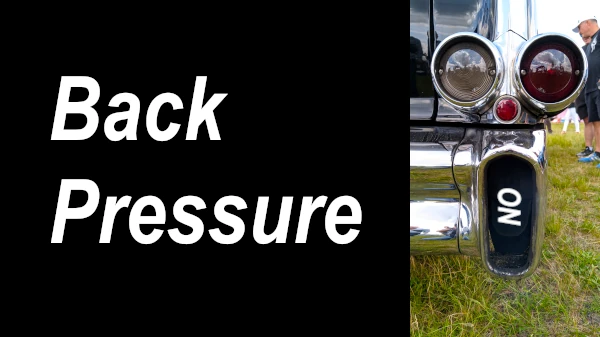Unraveling the Dynamics of Exhaust Back Pressure in Internal Combustion Engines
Exhaust back pressure, a term often surrounded by misconceptions, is at the heart of discussions concerning engine performance and efficiency. Contrary to popular belief, this article seeks to debunk the myth that high exhaust back pressure is beneficial for the engine. Instead, we will explore the nuances of this concept, shedding light on its impact on engine functionality and emissions.
Understanding Exhaust Back Pressure:
Exhaust back pressure is essentially the resistance faced by exhaust gases as they make their way from the engine to the atmosphere. This resistance arises from various restrictions within the exhaust system, influencing the flow of gases and, subsequently, the engine's overall performance.
The Impact on Engine Performance:
In debunking the myth, it becomes evident that exhaust back pressure adversely affects engine performance, efficiency, and emissions. This interference occurs during the crucial process of exhaust scavenging, where spent gases are evacuated, making way for the intake of fresh air. Excessive back pressure disrupts this cycle, leading to suboptimal engine operation.
Optimal Exhaust Back Pressure:
Determining the ideal level of exhaust back pressure is a complex task, contingent on several factors. The type and configuration of the engine, operating conditions, emission standards, and performance requirements all play pivotal roles in establishing the optimal back pressure for a particular setup.
Balancing Act:
In general, a lower exhaust back pressure is desirable, fostering improved exhaust flow, enhanced engine output, and a more pleasing exhaust note. However, it's crucial to strike a balance, as excessively low back pressure can introduce its own set of issues. Reduced effectiveness of Exhaust Gas Recirculation (EGR), heightened noise and vibration levels, and increased thermal stress on the exhaust system are among the potential drawbacks.
Designing for Optimal Performance:
To navigate this intricate balance, the exhaust system must be meticulously designed and tuned. Achieving the sweet spot requires a thorough understanding of the engine's needs, the vehicle's specifications, and the preferences of the end user. The goal is to create an exhaust system that optimally manages back pressure, ensuring both performance and longevity.
The Role of Engine Type and Configuration:
The optimal level of exhaust back pressure is not a one-size-fits-all solution. Different types of engines, such as naturally aspirated, turbocharged, or supercharged, have varying requirements. The configuration of the engine, including factors like cylinder arrangement and displacement, further influences the ideal back pressure. Engineers must tailor exhaust systems to these specific characteristics to achieve optimal results.
Consideration of Operating Conditions:
Operating conditions also play a pivotal role in determining the acceptable level of exhaust back pressure. Factors such as ambient temperature, altitude, and load conditions can impact the efficiency of the engine and, consequently, the ideal back pressure. Engineers must take these variables into account during the design process to ensure consistent performance across diverse scenarios.
Meeting Emission Standards:
In the modern era, stringent emission standards add an additional layer of complexity to exhaust system design. Striking a balance between low back pressure and emissions control is crucial. Advanced catalytic converters and emission control technologies are integrated into exhaust systems to ensure compliance with environmental regulations without compromising engine performance.
Performance Requirements and Preferences:
The balance between exhaust back pressure and engine performance is not solely a technical consideration; it also involves meeting the expectations and preferences of the end user. Performance enthusiasts may prioritize a sportier exhaust note and enhanced engine output, while others may prioritize fuel efficiency and a quieter ride. The design of the exhaust system must align with these diverse preferences to create a satisfying driving experience.
Potential Drawbacks of Too Low Back Pressure:
While a lower exhaust back pressure is generally favorable, it's important to acknowledge potential drawbacks. Insufficient back pressure can compromise the effectiveness of Exhaust Gas Recirculation (EGR) systems, which play a key role in controlling nitrogen oxide (NOx) emissions. Additionally, extremely low back pressure can result in increased noise and vibration levels, affecting the overall driving experience. Furthermore, the exhaust system may experience higher thermal stress and fatigue, potentially leading to durability issues.
Conclusion:
In conclusion, exhaust back pressure is a multifaceted aspect of internal combustion engines that demands a nuanced and comprehensive approach. By dispelling the myth that high back pressure is inherently beneficial, we pave the way for a more informed understanding of its role in engine dynamics. Designing exhaust systems that cater to the specific requirements of the engine and vehicle allows us to optimize performance, efficiency, and emissions, creating a harmonious synergy between exhaust back pressure and overall engine functionality. The intricate balance between these factors ensures that internal combustion engines continue to evolve, meeting the demands of both performance enthusiasts and environmentally conscious drivers.
